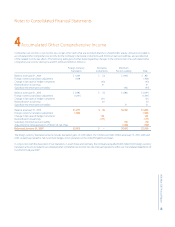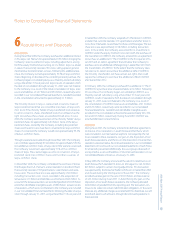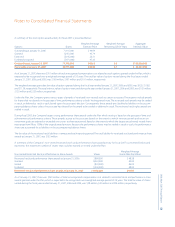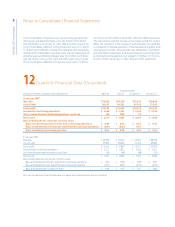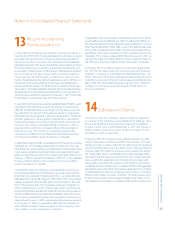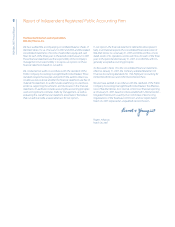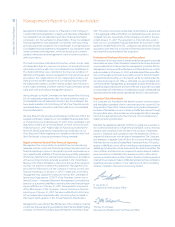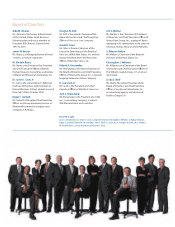Walmart 2007 Annual Report Download - page 61
Download and view the complete annual report
Please find page 61 of the 2007 Walmart annual report below. You can navigate through the pages in the report by either clicking on the pages listed below, or by using the keyword search tool below to find specific information within the annual report.
Wal-Mart 2007 Annual Report 59
Notes to Consolidated Financial Statements
13
Recent Accounting
Pronouncements
In June 2006, the Emerging Issues Task Force reached a consensus on
Issue No. 06-3 (“EITF 06-3”), “Disclosure Requirements for Taxes Assessed
by a Governmental Authority on Revenue-Producing Transactions.”
The consensus allows an entity to choose between two acceptable
alternatives based on their accounting policies for transactions in which
the entity collects taxes on behalf of a governmental authority, such
as sales taxes. Under the gross method, taxes collected are accounted
for as a component of sales revenue with an offsetting expense.
Conversely, the net method allows a reduction to sales revenue.
Entities should disclose the method selected pursuant to APB No. 22,
“Disclosure of Accounting Policies.” If such taxes are reported gross
and are signi cant, entities should disclose the amount of those taxes.
The guidance should be applied to nancial reports through retrospec-
tive application for all periods presented, if amounts are signi cant, for
interim and annual reporting beginning February 1, 2007. Historically,
the Company has presented sales net of tax collected.
In July 2006, the Financial Accounting Standards Board (“FASB”) issued
Interpretation No. 48, “Accounting for Uncertainty in Income Taxes”
(“FIN 48”). FIN 48 clari es the accounting for income taxes, by prescrib-
ing a minimum recognition threshold a tax position is required to
meet before being recognized in the nancial statements. FIN 48 also
provides guidance on derecognition, measurement, classi cation,
interest and penalties, accounting in interim periods, disclosure and
transition. The Company will adopt FIN 48 on February 1, 2007, as
required and for which the cumulative e ect will be recorded in
retained earnings. The Company is currently evaluating the
Interpretation to determine the impact the Interpretation will have
on its nancial condition, results of operations or liquidity.
In September 2006, the FASB issued Statement of Financial Accounting
Standards No. 157, “Fair Value Measurements” (“SFAS 157”). This stan-
dard de nes fair value, establishes a framework for measuring fair value
in generally accepted accounting principles and expands disclosures
about fair value measurements. The Company will adopt SFAS 157 on
February 1, 2008, as required. The adoption of SFAS 157 is not expected
to have a material impact on the Company’s nancial condition,
results of operations or liquidity.
In September 2006, the FASB also issued Statement of Financial
Accounting Standards No. 158, “Employers’ Accounting for De ned
Bene t Pension and Other Postretirement Plans – an amendment of
FASB Statements No. 87, 88, 106 and 132(R)” (“SFAS 158”). This standard
requires recognition of the funded status of a bene t plan in the state-
ment of nancial position. The standard also requires recognition in
other comprehensive income of certain gains and losses that arise
during the period but are deferred under pension accounting rules, as
well as modi es the timing of reporting and adds certain disclosures.
The Company adopted the funded status recognition and disclosure
elements as of January 31, 2007, and will adopt measurement elements
as of January 31, 2009, as required by SFAS 158. The adoption of
SFAS 158 did not have a material impact on the Company’s finan-
cial condition, results of operations or liquidity.
In September 2006, the Securities and Exchange Commission (“SEC”)
issued Sta Accounting Bulletin No. 108, “Considering the E ects of
Prior Year Misstatements when Quantifying Misstatements in Current
Year Financial Statements” (“SAB 108”), in which the Sta provides guid-
ance on the consideration of the e ects of prior year misstatements in
quantifying current year misstatements for the purpose of assessing
materiality. The Company adopted SAB 108 as of January 31, 2007, as
required. The adoption of SAB 108 did not have a material impact on
the Company’s nancial condition, results of operations or liquidity.
In February 2007, the FASB issued Financial Accounting Standards
No. 159, “The Fair Value Option for Financial Assets and Financial
Liabilities – Including an amendment of FASB Statement No. 115”
(“SFAS 159”). SFAS 159 permits companies to measure many nancial
instruments and certain other items at fair value at speci ed election
dates. SFAS 159 will be effective beginning February 1, 2008. The
Company is currently assessing the impact of SFAS 159 on its
financial statements.
14 Subsequent Events
On March 8, 2007, the Company’s Board of Directors approved
an increase in the Company’s annual dividend to $0.88 per share.
The annual dividend will be paid in four quarterly installments
on April 2, 2007, June 4, 2007, September 4, 2007, and January 2,
2008 to holders of record on March 16, May 18, August 17 and
December 14, 2007, respectively.
In February 2007, the Company announced the purchase of a 35%
interest in Bounteous Company Ltd. (“BCL”). BCL operates 101 hyper-
markets in 34 cities in China under the Trust-Mart banner. The purchase
price for the 35% interest was $264 million. Also in February 2007, the
Company paid $376 million to purchase a loan issued to the selling
BCL shareholders which is securitized by the remaining equity of BCL.
Concurrent with the initial investment in BCL, the Company entered
into a stockholders agreement which provides the Company with
voting rights associated with a portion of the common stock of BCL
secured by the loan, amounting to an additional 30% of the aggregate
outstanding shares. Pursuant to the purchase agreement, the Company
is committed to purchase the remaining interest in BCL on or before
February 2010 subject to certain conditions. The nal purchase price
for the remaining interest will be approximately $320 million, net of
loan repayments and subject to reduction under certain circumstances.


